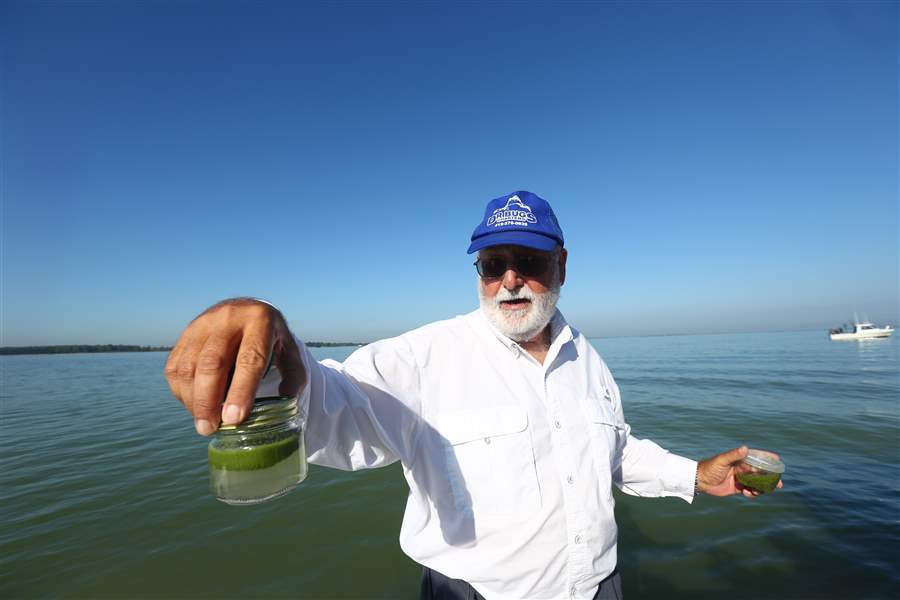
Officials take tour of Lake Erie algae bloom at its peak
9/15/2017
Capt. Dave Spangler holds samples of water from Maumee Bay, which shows the algae, Friday.
The Blade/Amy E. Voigt
Buy This Image
Policy discussions took a back seat to the real star of an all-day tour in eastern Lucas and western Ottawa counties Friday, an up-close look at the thick, menacing-looking toxic algae that is peaking in western Lake Erie.
Known as microcystis, the free-floating algae once again has transformed much of the basin into the color and texture of pea soup. Mats have formed a scum on the lake, with particles so dense the water seems to have chunks of algae in it.
Dave Spangler, vice president of the Lake Erie Charter Association, told people aboard his vessel the noxious algae has driven away 25 to 30 percent of his business, and hurt property values near his lakefront condo.
“Our business is entirely tied to what is going on in the lake,” Mr. Spangler, one of three charter boat captains shuttling 50 attendees out on the water near Maumee Bay State Park, said.
VIDEO: Dave Spangler talks about algal bloom on Maumee Bay
Customers from past years go elsewhere when it’s this bad. In addition to charter boat captains, algae costs fish-cleaning businesses, bait-and-tackle shops, and fuel docks money, he said.
“If 2012 and 2016 would be every year, we would stop yelling,” Mr. Spangler said, referring to two recent summers in which the western basin barely had any algae because there was little rain forcing algae-growing farm nutrients into Lake Erie tributaries.
The National Wildlife Federation’s Great Lakes office in Ann Arbor — which took journalists, public officials and others out on the lake during the 2014 Toledo water crisis — did a similar thing Friday from Maumee Bay State Park, where the toxin concentration of the bloom was recently measured at 250 parts per billion. That’s more than 12 times the threshold of 20 ppb for recreational activity.
Sandy Bihn, Lake Erie Waterkeeper founder and Lake Erie Foundation executive director, lives near Maumee Bay State Park. She said the park’s marina had little activity and that its Lake Erie beach was unusually quiet during what normally would be a packed Labor Day weekend.
“There wasn't a waverunner or anything here. It was horrible,” she said.
Morning boat rides were followed by a bus tour to three eastern Lucas and western Ottawa County sites that have benefited from the Great Lakes Restoration Initiative that President Trump has targeted for elimination.
RELATED: Concerns over algae at Thursday forum | Toledo water dashboard back to ‘clear’
Congress, for now, has maintained annual funding at $300 million a year.
At one stop, attendees toured the future Howard Marsh Metropark, a $14 million project to revert a large swath of land into a near-coastal wetland that is expected to help improve Lake Erie water quality while creating more wildlife habitat and better fish spawning. About $2.8 million of the tab is being covered by a GLRI grant issued by the National Oceanic and Atmospheric Administration, Tim Schetter, Metroparks of the Toledo Area natural resources director, said.
The site had been used as a farm for more than 100 years. Nearly 1,000 acres were acquired. The first phase involving 750 of them is the largest project ever undertaken by the park district.
When it is completed by the end of 2017, it will become the district’s second-largest park behind the Oak Opening Preserve Metropark, Denis Franklin, Metroparks natural resources supervisor, said.
The park will likely open to the public in the spring of 2018, and will offer miles of hiking trails, kayaking, and canoeing.
Another major project was shown at Cedar Point National Wildlife Refuge, where the U.S. Fish and Wildlife Service has worked with the U.S. Geological Survey and others to reconnect a near-coastal wetland to Lake Erie with a water-management structure that cost only $700,000. The site’s hydrology was artificially separated decades ago, officials explained.
That project also was fundedwith GLRI money. It is expected to reduce nutrients while improving the fishery and wildlife. Countless egrets and herons were seen in the refuge.
Attendees also toured the Jerry Whipple Farm in Ottawa County, which became one of the region’s first farms to embrace no-till farming when Mr. Whipple acquired the site in 1978.
Now 71, Mr. Whipple said he has enjoyed strong yields from no-till farming, and embraced many other water-conservation techniques that keep nutrients out of the lake, such as cover crops and buffer strips.
“Those cover crops are very, very important to us,” Mr. Whipple said, adding they fertilizer his soil like compost in the winter. “The soil is alive.”
While northwest Ohioans are becoming more familiar with those farming techniques, they might not realize that battles in Congress over issues such as the corn ethanol mandate have the potential of hurting Lake Erie water quality, David DeGennaro, NWF agriculture policy specialist in Washington, said.
About 15 percent of America’s fuel has ethanol in it, and about 40 percent of the corn grown today is used for ethanol production, he said.
Rising market prices for corn, driven by ethanol demand, have encouraged farmers nationally to farm to the edge of their fields rather than develop or maintain buffer strips, Mr. DeGennaro said, adding the issue is expected to be addressed by Congress in the coming months.
Jordan Lubetkin, NWF spokesman, said the Great Lakes region must fight to keep the GLRI funded.
“I don’t think in any way, shape, or form we can become complacent,” he said.
Contact Tom Henry at thenry@theblade.com, 419-724-6079, or via Twitter @ecowriterohio.